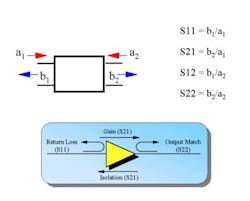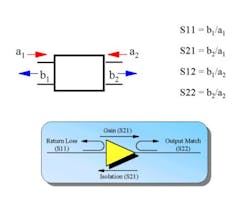Wireless Industry Spurs Demand for Very High-Frequency Test Systems
Millimeter-wave frequency bands offer tremendous promise for emerging applications in communications, identification, and collision avoidance. In addition to being less congested than bands at lower frequencies, they provide the wide bandwidths needed for multichannel communications and high data rates.
Today, hardwire solutions to ease data traffic congestion include digital subscriber lines (DSL) and cable modems. Although DSL and cable modem technologies have improved significantly, they still cannot satisfy the burgeoning need for bandwidth. They also are slow and expensive to deploy. As conventional wireline technologies approach their bandwidth limitations, broadband wireless access (BWA) has fast become a welcome and cost-effective alternative.
While satellites can provide BWA, the more common implementations are Local Multipoint Distribution System (LMDS) applications. These are fixed wireless services operating in the Ka band at frequencies from 28 to 32 GHz.
Many factors play a role in the success of wireless broadband technology. For LMDS service providers to fully realize the revenue potential of this market, they must penetrate the residential consumer marketplace by offering services that are better and lower cost than what residential consumers already get.
The capability, then, to manufacture, test, and deliver a high volume of millimeter-wave (gallium arsenide) components for high-performance, high-frequency radios and networks while still maintaining a low cost of test is particularly challenging. Components and radio manufacturers must change their manufacturing and testing strategies.
Selecting a High-Volume Test System
The following are some of the key factors to consider before investing in a millimeter-wave device automated production test system:
- The test system must provide high-frequency measurement capabilities up to 45 GHz with fast measurement times. The need for 45 GHz is driven by the need to test a broad range of millimeter-wave devices that operate at digital radio frequencies of 15, 18, 23, 28, 38, and 42 GHz. The 45-GHz top frequency also provides the capability to measure the 2nd, 3rd, and 4th order harmonics for lower-frequency applications.
- The system software must be easy to use, quick to learn, and effortless when it comes to developing test plans to bring new parts online quickly and at full capacity. Having a suite of built-in tests provides point-and-click selection and consistency of industry-standard test methodologies. The system must have a comprehensive set of key built-in measurement capabilities that includes gain, gain compression, efficiency, harmonic distortion, power, known spurious signals, S-parameters, supply currents, voltages, noise figure (NF), mixer conversion gain, and Nth order intermodulation in one pass.
- The test system must be flexible and expandable to meet changing test requirements and device complexities while lowering test and operational costs. A typical rack-and-stack configuration usually makes a narrow set of measurements or, at best, it only can test one type of device. The test system should be easily reconfigured for testing a variety of devices including amplifiers, mixers, and low-noise amplifiers (LNAs) in one pass. This flexibility makes capacity balancing easier.
Meeting Test Challenges in High-Volume Production
Several key challenges face manufacturers when testing at millimeter-wave frequencies.
High Measurement Speed
In the traditional method of volume testing, individual instruments, often optimized for dedicated measurements, would be stacked together using a switch to connect the separate instruments to the device-under-test (DUT). Simple system software would be put in place to control the test setup. When switching from one type of measurement to another, the system software must sequentially poll one instrument at a time, often repeating unnecessary traffic between instruments, before the next measurement can be made. This is a very time-consuming and inefficient test process.
The system of today meets this challenge head-on by using a single integrated receiver to handle multiple measurements on the DUT while minimizing human interaction to create a true high-volume test environment. Using an integrated receiver with smart system software, reconfiguration time virtually is eliminated when switching between different types of measurements. System software not only features a built-in algorithm to track hardware states, but it also queues up hardware changes to minimize measurement time.
Fast Test-Plan Development
The capability to quickly deploy the test plan, combined with the agility to upgrade and modify the system without reconfiguration or downtime, is key. The system must be fully functional upon installation and capable of testing new parts as they come online without a major manufacturing disruption.
Test-plan deployment is aided significantly by incorporating easy-to-use system software. The point-and-click approach to system software, along with a forms-based graphical user interface (GUI), means you don’t have to spend hours writing specialized code for each measurement required (Table 1).
Table 1. Full Suite of Measurement Capabilities
| Adjacent Channel Power Adjacent Channel Power: CDMA Adjacent Channel Power: PDC Adjacent Channel Power: PHS Distortion: Harmonic Distortion: Intermod Gain Gain Compression: Linear Power Sweep Gain Flatness Mixer Leakage and Match Terms Noise Figure: Frequency Translating Noise Figure: Linear Phase Noise: Multiple Offset Power Out (of DUT) Power Out (of DUT): Modulated Power: Incident (to DUT) and Match Power: Incident (to DUT) and Modulated S-Parameters: One-Port S-Parameters: Two-Port Spurs Voltage |
Accurate Calibration
Accurate calibration also is vital to making measurements at millimeter-wave frequencies. After the test plan has been developed but before measurements are made, a calibration routine typically is performed. The system software uses the test plan to walk you through the calibration process. In this manner, calibration is performed only on the measurements called out in the test plan. No additional time is spent doing unnecessary calibrations.
Another system software requirement is a de-embedding function that makes it possible to calibrate all the way to the probe tips in on-wafer test or remove the effect of the fixture in module test. You achieve better test accuracy and avoid shipping bad parts or failing good parts.
High-Frequency Measurements
As previously stated, an effective millimeter-wave device test system must have a comprehensive set of test capabilities. For example, two tests on the list are S-parameters and 3rd order intermodulation.
S-Parameters
S-parameters comprise a tool set that describes the parameters of linear high-frequency networks. In many ways, they are similar to Z or Y parameters described by voltages or currents. The use of Z or Y parameters at high frequencies, however, is impractical because the voltages and currents used to describe them vary in amplitude along a transmission line, making them difficult to measure.
S-parameters are ideal for describing high-frequency devices because they use waves that are incident or reflected from a network. These do not vary in amplitude along a transmission line. S-parameters contain both magnitude and phase information (Figure 1).
Figure 1. S-Parameters
To make S-parameter measurements, it is necessary to separate the waves traveling in each direction. Separation is done by reflectometers. With reflectometers, along with an RF synthesizer to supply the necessary incident signal and other components of the system, measurements of all four S-parameters can be made.
3rd Order Intermodulation
Third-order intermodulation (IP3) distortion, like 1-dB gain compression, is a measure of amplifier nonlinearity. When two or more signals, f1 and f2, at different frequencies are applied to an amplifier, nonlinearities in the amplifier cause the output to contain additional mixing frequencies called intermodulation (IM) products. They are at (mf1 ± nf2) and at (mf2 ± nf1) where m + n is the order of the IM product.
Even-order products are located near the baseband while odd-order products are located on either side of the input signals. Third-order products are closest to the input test frequencies and the most difficult to filter. When the amplitudes of the f1 and f2 pair (fundamental) are equal and in the amplifier linear region, for each 1-dB increase in fundamental power, the amplitude of the 3rd order products increases 3 dB. If these two transfer functions were extrapolated and plotted, the theoretical power where they are equal is called the IP3. It can be referred to the input or output (Figure 2).
Conclusion
Mounting consumer demand for faster, better products means millimeter-wave manufacturers are increasingly sensitive to time-to-market and cost-of-test pressures. Further complicating matters, these manufacturers need to get their next-generation products to market on the first try or risk being left in the dust by the competition. The role of test becomes eminently important in this environment, behooving the savvy manufacturer to use the most reliable and cost-efficient testing solutions available to reduce the various market pressures they encounter.
About the Author
Jane L. Huynh has been with Agilent Technologies and Hewlett-Packard for 10 years, currently as a product manager for the Agilent 84000 Millimeter-wave Series Test System. She received a B.S.E.E. from the University of Washington. (707) 577-2884.
Gordon J. DeWitte has been with Agilent Technologies and Hewlett-Packard for 15 years. Presently, he serves as product manager for the Agilent 84000 Millimeter-Wave Series Test System. Mr. DeWitte earned a B.S.E.E. from the Massachusetts Institute of Technology. (707) 577-3887. Agilent Technologies, 1400 Fountain Grove Parkway, Santa Rosa, CA 95403.
Published by EE-Evaluation Engineering
All contents © 2000 Nelson Publishing Inc.
No reprint, distribution, or reuse in any medium is permitted
without the express written consent of the publisher.
May 2000

